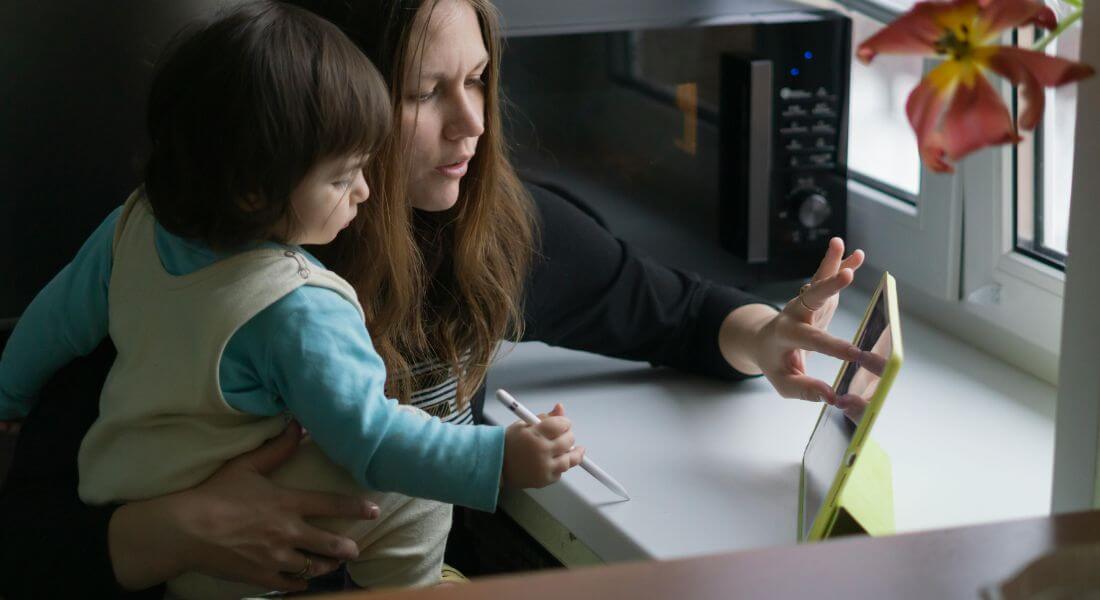See Beyond the Screen: Benefits of Diagnosing Autism Through Telehealth Appointments
November 13, 2024
November 13, 2024

As science and technology evolve, it’s natural to have questions. As such, the introduction of telehealth to conduct diagnostic evaluations has sparked many questions, including:
“Can autism be diagnosed via telehealth?”
“Though telehealth is not the historical practice method for autism testing, it is possible to reach a diagnosis,” said Hopebridge Founder and Head of Clinical Strategy Kim Strunk. “The ultimate goal is to have the child in an environment where they feel safe and secure, and where the diagnostician can view what the family is really experiencing. This allows us to be the most impactful in addressing their needs.”
Hopebridge offers reliable autism-specific evaluations via virtual platforms, which allows us to connect with children and families from the comfort of their own homes. Research and our experience with this practice at Hopebridge shows that not only are virtual appointments a viable option to diagnose autism spectrum disorder (ASD), but they can also provide benefits that are not available to families during in-person evaluations.
To give families and physicians a better picture of our telehealth autism evaluations, we spoke with Kim and Hopebridge Regional Directors of Psychological Services Ruth Bernstein and Laura Wendlandt. Together, they answered some of the most common questions to dispel myths around virtual autism evaluations, as well as discussed the advantages and provided tips for families going into a telehealth appointment.

Hopebridge offers flexible autism testing options virtually.
Just like in-person evaluations, Hopebridge’s virtual appointments start with caregiver interviews. These interviews target specific areas of autism and help the diagnostician follow up on some of the information from the pre-appointment paperwork.
“Giving families the time and space to tell their story is an important piece of the evaluation,” said Ruth. “We use this time to obtain as rich of a picture of the child as possible.”
Depending on the child and their individual needs, the diagnostician may conduct testing and feedback within the same telehealth appointment as the interview or arrange a separate appointment for testing.
Testing typically involves two separate assessments for autism that can be administered simultaneously. During this time, the diagnostician will guide the child and caregiver through specific tasks and observe the child as they interact and play with their caregiver. The diagnostician will observe the child’s behaviors, such as their eye gaze, their response to someone saying their name, and how they play with various toys.
Our team acknowledges that this part can sometimes feel a bit awkward for parents. Ruth said that she often tells families, “I’m going to get a little bossy, and it might feel a little weird because you’ve probably never had another adult tell you how to play with your child, but it’s normal for this process.”
Kim echoes this sentiment, saying, “Our team of diagnosticians is experienced and trained for this platform. They will put you at ease, answer questions and walk you through every step. In no way are they evaluating how you play with your child; they are evaluating how your child responds to different requests asked of them. Rest assured; you are never being judged on how you interact with your child!”
Following the assessments, the diagnostician will provide families with an answer to the question of whether their child meets the criteria for a diagnosis of autism, as well as recommendations, including next steps. Families will receive the full report at a later time. For more information on the general process, check out our blog post on what to expect during an autism evaluation.
Now that you know more about what to expect in the evaluation, you may still have some questions. Hopebridge’s diagnostic team answered some of the frequently asked questions about autism testing via telehealth platforms.
Are autism assessments conducted virtually as accurate as in-person evaluations?
It is not necessary to be in the same room as a child to evaluate them for autism. We can obtain a clear and accurate picture of a child’s skills and behaviors when observing them in their natural environment and administering standardized assessments virtually. This also reduces stress the child may feel when in an unfamiliar setting. Hopebridge uses assessments designed specifically for telehealth purposes based on the same principles as the “gold standard” of assessments for autism.

Telehealth services at Hopebridge allow diagnosticians to see behavior in the home environment.
How long does a typical telehealth evaluation take?
An entire evaluation averages two hours, held over one or two appointments, including interviews, testing, and feedback. During a telehealth appointment, the testing portion takes approximately 15-20 minutes but will vary based on each child. The diagnostician will continue guiding the family until they see what they need from the child to determine if the child meets the criteria for a diagnosis of autism.
How can you determine a diagnosis after only 15-20 minutes of direct testing?
Visible testing is only one piece of our process. We are gathering data during caregiver input even before we administer the two assessments simultaneously. In-person assessments can take longer because it is necessary to ensure what we observe is not due to environmental variables, while virtual platforms remove these factors. This is a huge perk of telehealth evaluations for families. The process is faster than people often expect, but we are still able to complete standardized assessments that have validity in diagnosing the child.
Is telehealth suitable for all children?
Every child and family are unique. Our team is trained to determine what is best for the child and may suggest in-person assessments for some families, if necessary.
What is the best device to use for telehealth autism evaluations?
Some parents are concerned if they do not have a laptop or desktop computer, but there is no need to worry! Our diagnosticians say it is easier for families to participate in the evaluations via a smartphone or tablet because children do not stay in the same spot, therefore mobile devices are easier to adjust and move. It is also helpful to have two adults on site so one can direct the camera and the other can engage with their child.
To get families the answers they need regarding their child’s behaviors and challenges, Hopebridge’s telehealth evaluations offer benefits that other providers or evaluation processes may not be able to offer.
Hopebridge’s virtual autism evaluations offer convenience and comfort without compromising quality. Telehealth testing can shorten wait time and provide results that are as reliable as those determined during in-person assessments, making it a great option for many families to get the answers they need to begin intervention during their child’s critical developmental years.
If you are a family interested in learning more about Hopebridge’s diagnostic evaluations and other services such as applied behavior analysis (ABA), speech therapy and occupational therapy, please fill out the brief contact form on our website.
If you are a physician looking to refer a patient for an autism evaluation or therapy options for ASD or another developmental disorder, please submit a referral here.
*Informed consent was obtained from the participants in this article. This information should not be captured and reused without express permission from Hopebridge, LLC.
Hopebridge in the News
August 06, 2019
Hopebridge Brings Pediatric Autism Therapy Centers into Arizona
Parenting Resources
August 03, 2021
How Hopebridge 360 Care Prepares Kids with Autism for the Classroom
Parenting Resources
June 13, 2023
What to Expect from Autism Testing: The Process for an Autism Diagnosis for Children